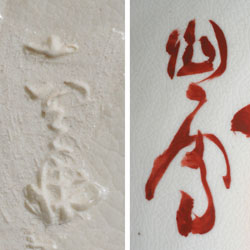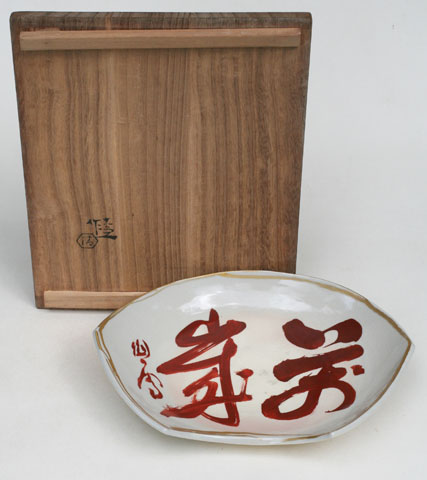Kyôyaki
Sensukei kashibachi, fan-shaped dish – Banzai, congretulationsSigned: Kansetsu
Seals: Rokubei
Technique: fine grey crackled kôyaki glaze with an aka red overglaze calligraphy and golden edges 26,5 x 20 x 6,8
Date: 1928
Box: signed by both painter and potter
Condition: very good
Kansetsu was born in Kobe from a family of artistic background. Kaikan, his father was a painter, poet and scholar of Chinese classics, his mother an amateur painter and his grandfather a famous haiku poet. Because of his father’s reputation Kansetsu's parental home was a meeting point for artists and scholars from China as well as from Japan. After receiving his first training from his father, Kansetsu studied Shijô painting with Kataoka Kôkô (dates unknown). In 1903 he continued his studies with Takeuchi Seihô (1864-1942), who had just returned from Europe. Kansetsu and Seihô never got along very well and in 1923 they finally broke up. In 1913 Kansetsu travelled to China, a country he revisited more than 30 times. In 1921 and 1927 he went to Europe. Kansetsu was a member of the Art Committee of the imperial household and the Imperial Art Academy, and a constant exhibiter at the Bunten.
Reference:
Kyoto 1957
Kyoto 1977
Conant pp. 293-294
Berry & Morioka ‘99 pp. 224-29
Berry & Morioka ‘08 pp. 261-63
Roberts p. 41
Rokubei V, the second son of Kiyomizu Rokubei IV, studied Shijô painting with Kôno Barei (1844-1895) and also at the Kyoto Prefectural School of Painting. After his graduation he studied ceramic techniques with his father and glazing techniques at the Kyoto Municipal Ceramic Laboratory. He worked on the research of new glazing techniques and western designs. When Rokubei IV retired in 1913, he inherited the title and became Rokubei V. He exhibited at the Nôten, the Design and Applied Artworks Exhibition sponsored by the Ministry of Agriculture and Commerce, and at the Teiten, the Imperial Art Academy Exhibition. He also became a member of the Imperial Art Academy and played an important role as a leading figure of the craft world. In 1945 he retired.
Reference:
Kyoto ‘03, ’Sekka’ p. 326 ff.
Price: ON REQUEST

